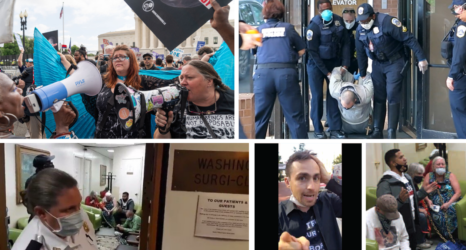Earlier this month, the U.S. Justice Department announced a lawsuit against the State of Michigan on the grounds of systematic gender discrimination against women corrections officers. The lawsuit shows that existing efforts to stop institutional sexism in the state—and around the nation—aren’t enough.
Citing Title VII, which “prohibits discrimination in employment on the basis of race, color, sex, national origin and religion,” the Justice Department accused MDOC and the Women’s Huron Valley Correctional Facility (WHV) of using its “overly broad female-only assignment policy” to discriminate against female employees. According to the report, 28 female officers had issued a complaint with the EEOC after they suspected MDOC of denying them transfers or other employment opportunities since 2009.
In 1996, Human Rights Watch reported that sexual assault as well as “other misconduct by corrections staff” directed at women police officers in Michigan continued to be “tolerated over the years at both the institutional and departmental levels.” This scathing report—and others like it—pushed the Michigan Department of Corrections (MDOC) into implementing a new policy that would restrict responsibilities involving housing and transportation in women’s prisons to female corrections officers. Now, 20 years later, MDOC has found itself once more at the center of a fight against systemic sexism in policing.
Unfortunately, the plight of these WHV correctional officers is one felt by many women in all facets of law enforcement. A 2005 report by the Bureau of Justice Statistics revealed that out of an estimated 445,000 employees working in state and federal correctional facilities, about 25% were women. Though significantly higher than the minuscule 12% of female, active duty police officers in 2015, female corrections officers were still a significant minority.
Many of the pitfalls of being a woman in the law enforcement industry still apply in correctional facilities. In one study, female corrections officers reported feeling discriminated against in the workplace and pessimistic about the possibility of growth in their field. Several mentioned instances of sexual harassment, troubles balancing their family with their career and frustration with what they perceived to be institutional inequality. Of the 12 officers interviewed, none believed women had “greater opportunities for promotions in the correctional setting.”
If there had been more prominent examples of promotion and inclusion in the corrections industry, the 12 officers interviewed might have told a very different story. One study suggests that the solution might lie in diversifying the workplace, finding that when there are more women working lower-level jobs, there are likely more women in executive or managerial positions as well.
But it isn’t just women who benefit from a growing number of women in policing and law enforcement—the public benefits, too. In 2003, the Feminist Majority Foundation (FMF) published a report finding that a higher proportion of female officers would help put an end to workplace discrimination and emphasizing the several ways women could overhaul institutional problems in policing. (Women were found to perform just as well as their male counterparts but were less inclined to use force and more likely to reduce cases of sexual harassment.)
Why should it be any different for correctional officers? The relationship between prisoners and officers has been tenuous at best over the years, with instances of aggression becoming increasingly commonplace. Just this month, five prison guards—all men—were convicted for assaulting an inmate in New York City’s Riker Island jail complex. With time, an increase of female employees in both men’s and women’s prisons could help quell this growing hostility and reduce the possibility of physical confrontation between officer and inmate.
However, for reasons that continue to elude most women, institutions like law enforcement can’t seem to wrap their head around the idea of using gender equality as a means to resolve its structural flaws. The FMF’s report on policing has been out for over decade, yet most police departments in the U.S.—whether they be in Colorado Springs or in Los Angeles—have found ways to continue enforcing discriminatory practices.
Can the same thing be said about the prison system? Absolutely. As this current lawsuit shows, it’s unlikely that MDOC would have made a genuine effort to correct its mistakes without the Justice Department taking action on behalf of the women working at WHV. Female employees in the prison system are currently being punished for the misconduct of their male counterparts—their careers are limited by a policy that, in theory, should have no effect on their career prospects.
Should the Justice Department wins this case, the court’s ruling should lead to some serious institutional changes that will set a precedent for all women in law enforcement. Maybe that’s the wake-up call law enforcement leaders across the nation need right now.
Nicole Pina is an editorial intern at Ms. and a rising junior pursuing an English degree at Yale University. She spends most of her time either reading medieval poetry or editing other people’s essays on medieval poetry. When not subjecting her friends to a rant about the lyrical virtuosity of Kate Bush’s >Hounds of Love, she works as an editor at her college’s multilingual magazine and helps host a feminist radio show.





